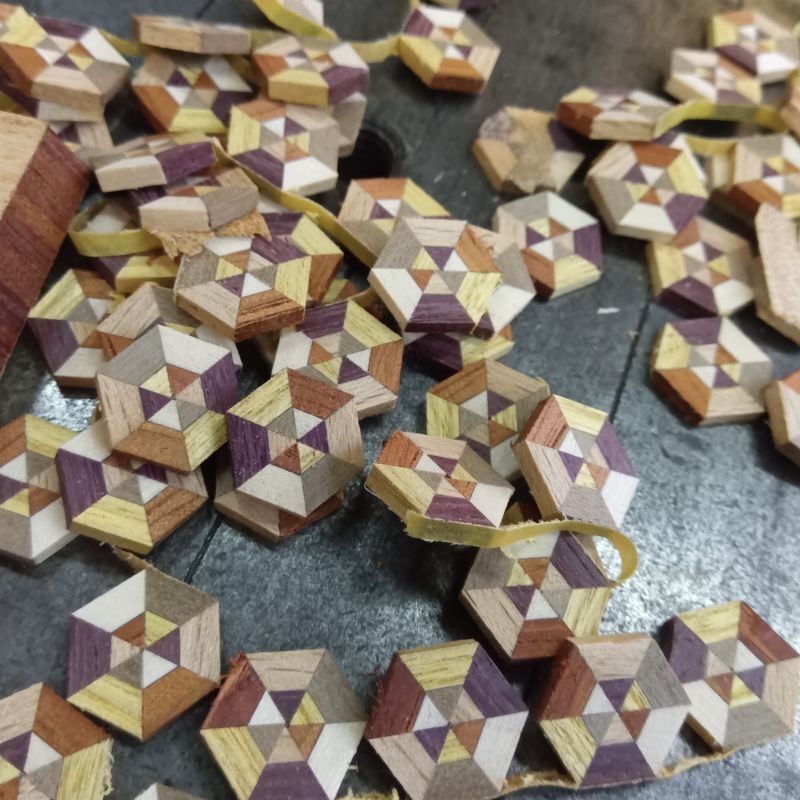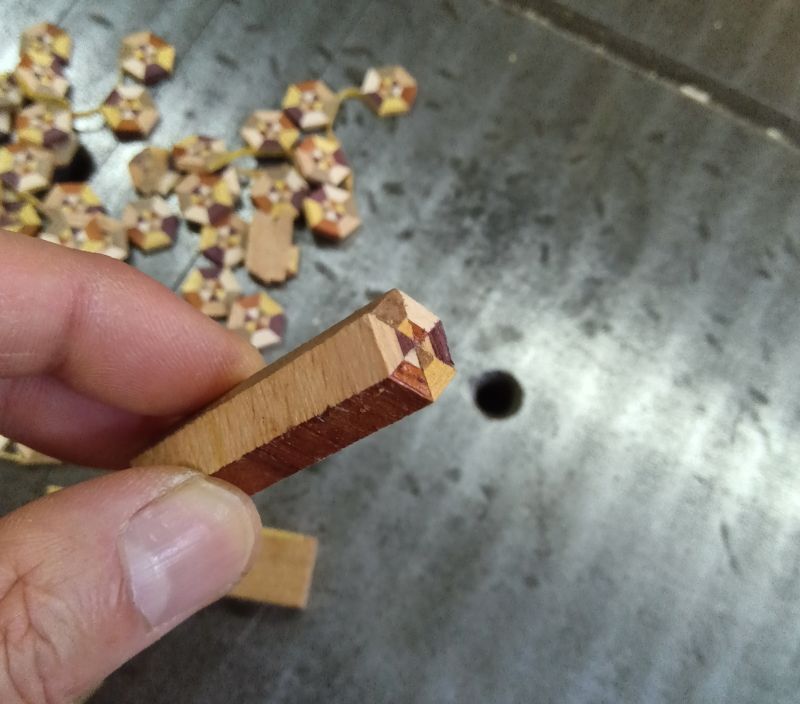Solid hexagon yosegi
I received an order for the Mame Japanese puzzle box with 18 steps, so I started preparing to make it today. This box is a Mame puzzle box with 18 moves, and it features a solid walnut wood top and bottom panels. On top of the panel, there's a solid (natural wood) hexagonal yosegi design, which is glued down securely. This hexagon yosegi is purely decorative, but because of its charming appearance, this tiny box is quite popular.
So far, this is the only box that features a solid wood yosegi design attached in this way. Design-wise, there are some lids with wood inlays, such as solid yosegi or stripe patterns embedded within the surface of top panel, but none where the yosegi is raised in a three-dimensional like this. I'd like to create boxes with this kind of design in other sizes as well. However, for larger boxes (for example, 4 sun or 5 sun size), it might be disproportionate from a design perspective.
As you might see in the photos, this solid hexagonal yosegi is about 2mm thick, and its color is very vibrant. Compared to sliced yosegi-sheet, solid wood yosegi like this really brings out the natural color of the wood. Of course, the wood used in this solid hexagonal yosegi is not dyed; the colors are the natural shades of each type of wood. The woods used are urushi, purpleheart, mizuki (dogwood), hoo (magnolia), beech, and rengas. Since it's a hexagon, there are six colors. The process involves gluing together six triangles, each made from two different types of wood, to form a hexagonal rod. This rod is then cut into 2mm pieces. This method is a basic technique in Hakone yosegi-zaiku.
When we think of yosegi-zaiku, many products use sliced sheets adhered to boxes and other items, but there are also products that use solid yosegi. For example, large blocks of yosegi can be carved or hollowed out to make items like cups. This type of yosegi work is also traditionally done in countries outside of Japan. Therefore, the method of creating products by pasting sliced yosegi sheets to boxes and other items is a technique unique to the Hakone region.
So far, this is the only box that features a solid wood yosegi design attached in this way. Design-wise, there are some lids with wood inlays, such as solid yosegi or stripe patterns embedded within the surface of top panel, but none where the yosegi is raised in a three-dimensional like this. I'd like to create boxes with this kind of design in other sizes as well. However, for larger boxes (for example, 4 sun or 5 sun size), it might be disproportionate from a design perspective.
As you might see in the photos, this solid hexagonal yosegi is about 2mm thick, and its color is very vibrant. Compared to sliced yosegi-sheet, solid wood yosegi like this really brings out the natural color of the wood. Of course, the wood used in this solid hexagonal yosegi is not dyed; the colors are the natural shades of each type of wood. The woods used are urushi, purpleheart, mizuki (dogwood), hoo (magnolia), beech, and rengas. Since it's a hexagon, there are six colors. The process involves gluing together six triangles, each made from two different types of wood, to form a hexagonal rod. This rod is then cut into 2mm pieces. This method is a basic technique in Hakone yosegi-zaiku.
When we think of yosegi-zaiku, many products use sliced sheets adhered to boxes and other items, but there are also products that use solid yosegi. For example, large blocks of yosegi can be carved or hollowed out to make items like cups. This type of yosegi work is also traditionally done in countries outside of Japan. Therefore, the method of creating products by pasting sliced yosegi sheets to boxes and other items is a technique unique to the Hakone region.

